Ismael
An Educational Magazine for Waqifeen-e-Nau
















“The

WAQF-E-NAU (CENTRAL)
+44 (0)20 8544 7633
+44 (0)20 8544 7643
manager@ismaelmagazine.org editorenglish@ismaelmagazine.org editorurdu@ismaelmagazine.org


















“The

WAQF-E-NAU (CENTRAL)
+44 (0)20 8544 7633
+44 (0)20 8544 7643
manager@ismaelmagazine.org editorenglish@ismaelmagazine.org editorurdu@ismaelmagazine.org

To subscribe to the Isamel Magazine contact your National Secretary Waqf-e-Nau
UK- Anas Ahmad Rana waqfenau@ahmadiyyauk.org
Canada - Basil Raza Butt waqfnau@ahmadiyya.ca
USA - Mirza Harris Ahmad national.wn@ahmadiyya.us
Australia - Ataul Awal nsahmad@hotmail.com
Spain - Qaiser Malik qaismalik10@gmail.com
Belgium - Munir Ahmed Anjum waqfe.nau@ahmadiyya.be
Ghana - Hafiz Abdullah Mohammad sani waqf-e-nau@ahmadiyya.org.gh
Switzerland - Jariullah Zafarullah waqfenau@ahmadiyya.ch
Ireland - Attaur Rehman Khalid waqfenau@islamahmadiyya.ie
Mauritius - Mohsin Ahmad Ramjeet waqfenaumauritius@gmail.com
Sierra Leone - Shahid M. Korjie waqfenau.sl@gmail.com
New Zealand - Muhammad Yaseen yasinsec681@hotmail.com
France - Ashfaq Rabbani mrehman@hotmail.fr


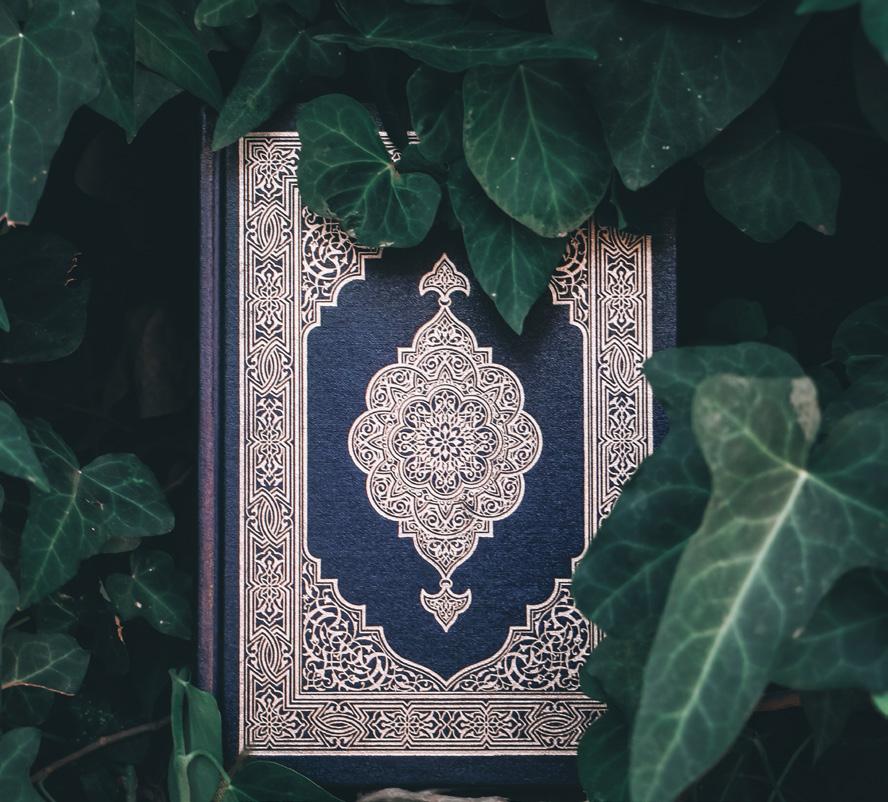

Dr Rabeel Ahmed
Zaviyar Ahmad Khan

Chief Editor & Manager: Luqman Ahmed Kishwar
English Editor: Talat Syam
Urdu Editor: Farrukh Raheel
Editorial Team: Touqeer Tanvir
Farukh Arshad
Musharraf Ahmed
Talat Syam
Content manager: Noman Ahmed
Raheef Ahmad Muslun
Cover design:
Labeed Mirza
Farhad Ghaffar

Designing Team:
Talat Syam (Lead Designer)
Ehtesham Ul Islam
Asim Javed
Danish Ahmad
Proofreading: Sadiq Ahmed
Anas Mahmood
Dr Mahmood
Jalees Khan
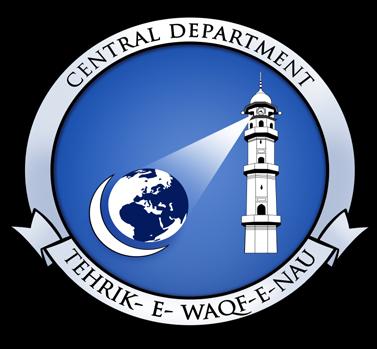



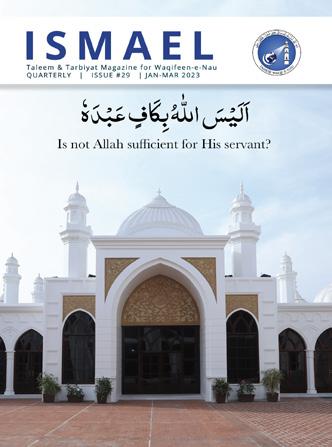

By the grace of Allah Ta'ala, Waqifeen-e-Nau are now spread across the globe, many of whom are studying in their respective fields while others have already fulfilled their pledge of dedicating their lives for the Jama’at. There are many who are Missionaries, practising Doctors, Television producers, Architects, Graphic designers, Engineers, Accountants and much more.
Ismael is an international magazine, which was launched in 2012 by Hazrat Khalifatul-Masih the fifthaba specifically for the Waqifeen-e-Nau around the world. At this auspicious occasion, addressing the Waqifeen-e-Nau Huzoor-e-Anwaraba wrote:
“The magazine has been named as “ISMAEL”, which reminds us of the sacrifices made by Hazrat Ismaelas and by Hazrat Hajiraas who spent their lives in a desolate and barren place and instituted exceptional standards of sacrifices for the sake of religion. Likewise, it is expected of every Waqf to uphold the covenant of Waqf (dedication) made by their parents even before their birth, who have in turn themselves reaffirmed the same.”
Waqifeen-e-Nau can contribute by sending articles regarding their respective fields of studies. This magazine is published on a quarterly basis as a platform for the Waqifeen-e-Nau to get in touch and express what they have always wanted to. To subscribe to this magazine, you can contact your National Waqf-e-Nau Secretary. You can also read the magazine online at: www.waqfenauintl.org/resources/ismael
Remember, this magazine is for the Waqifeen-e-Nau, prepared by the Waqifeen-eNau. Everyone is welcome to send their articles, contributions and comments. Ismael magazine is the central magazine for Waqifeen-e-Nau from around the globe.

And when My servants ask thee about Me, say: ‘I am near. I answer the prayer of the supplicant when he prays to Me. So they should hearken to Me and believe in Me, that they may follow the right way.’
The Holy Qur'an 2:187
The Holy Prophetsa said, ''Allah says: 'I am just as My slave thinks I am, (i.e. I am able to do for him what he thinks I can do for him) and I am with him if He remembers Me. If he remembers Me in himself, I too, remember him in Myself; and if he remembers Me in a group of people, I remember him in a group that is better than they; and if he comes one span nearer to Me, I go one cubit nearer to him; and if he comes one cubit nearer to Me, I go a distance of two outstretched arms nearer to him; and if he comes to Me walking, I go to him running.' ''
Sahih al-Bukhari 7405

Therefore there is no question that the True and Perfect God, to believe in Whom is essential for every person, is the Lord of all the worlds. Furthermore, His providence is not confined to any particular people, age or country. In fact, He is the Lord of all peoples, the Lord of time and space, and He is the Sovereign of all the countries.
He alone is the Fountainhead of all beneficence and the Source of every physical and spiritual strength. All that exists is sustained by Him. He is the Support for every creature. It is the universal beneficence of God which encompasses all peoples, all countries and all ages. It so happened lest anyone should have cause to complain that: ‘God has bestowed His favour upon such and such people, but not upon us.’ Or that: ‘So and so received the Book in order to be guided while we did not.’ Or that: ‘In such and such an age, He revealed Himself through His revelations, communications and miracles but in our time He remained hidden.’ Thus, by demonstrating His universal beneficence, He left no justification for such possible accusations. He displayed His virtues boundlessly so that no people remain bereft of physical and spiritual bounties from Him. He also did not treat any age as doomed.
(A Message of Peace, pages 9-10)

During a virtual sitting of the students of Jamia Ahmadiyya Ghana with Hazrat Amirul Momineen, Khalifatul Masih Vaa, which was held on 5 December 2020, a student asked Huzooraa what the strongest proof [for the existence of God] was to make those people who did not believe in God Almighty understand.
Hazrat Khalifatul Masih Vaa replied: “The fact is that those who do not believe in God Almighty do not wish to even listen [to such proofs]. The strongest proofs for the existence of God Almighty are your personal experiences with Him.
“Tell them, ‘You say that God does not exist. I say there is a God as I asked of Him and He gave me what I prayed for.’ You have had your prayers answered, right? Has Allah ever accepted a prayer of yours? Have you ever prayed for something and had that prayer accepted? (The student answered in the affirmative.) So, say to those people who do not believe in God, ‘You say that God Almighty does not exist. I sought something from Allah the Exalted and He granted it to me. I have a personal experience of Allah the Exalted. How can I say that there is no God? If you also make an effort, you can find Allah as well.’
Al Hakam: What is the strongest proof for the existence of God that one could present to those who do not believe in God?, 3rd December 2021
‘I shall Humiliate him who Designs
thee’

The existence of God has been a subject of debate throughout human history, yet certain phenomena serve as powerful signs pointing towards divine truth. Among these, the fulfilment of prophecies stands out as a significant demonstration of God’s continuous communication with humanity. One of the most compelling proofs of God’s existence can be found in the prophetic revelations granted to Hazrat Mirza Ghulam Ahmad of Qadianas. His prophecies, many of which came to pass with precise accuracy, offer undeniable evidence of a higher, divine power at work in the world.
Among the most striking examples of these prophecies is the case of Pandit Lekhram, a fierce critic of Islam and Hazrat Mirza Ghulam Ahmadas. The prophecy concerning Pandit Lekhram’s death stands as a clear and remarkable testament to the truth of divine revelation and the existence of God. This article will explore the details of the prophecy, its fulfillment, and how it serves as proof of divine guidance and communication.

Pandit Lekhram was a prominent figure in the Arya Samaj, a Hindu reformist movement, and an aggressive opponent of Islam and Hazrat Mirza Ghulam Ahmadas. He was known for his inflammatory writings against the Holy Prophet Muhammadsaand Islam, and his relentless mockery of Hazrat Mirza Ghulam Ahmadas. Pandit Lekhram’s opposition took the form of publications in which he insulted the Holy Prophetsa and ridiculed the message of the Promised Messiahas.
In response to this aggressive and abusive behavior, Hazrat Mirza Ghulam Ahmad responded both through debate and, more importantly, through divine revelations that foretold the fate of Pandit Lekhram.
The Prophecy of Pandit Lekhram’s Death:
The prophecy concerning Pandit Lekhram’s death was made public by Hazrat Mirza Ghulam Ahmad on February 20th, 1893,
and published in his book Barahin-e-Ahmadiyya as well as other writings. This prophecy was not vague but filled with specific details, including the time frame and nature of Lekhram's death. The following is the exact wording of the prophecy:
"A calamity will overtake him [Lekhram] within six years in punishment for his blasphemy against the Holy Prophet (peace be upon him). A grievous end awaits him, and his death will be a violent one."1
Further revelations about Pandit Lekhram’s death were also received by Hazrat Mirza Ghulam Ahmad, including a vision in which an angel wielding a bright sword symbolized that Lekhram would meet a violent and sudden end. Another revelation specifically indicated that this death would occur on the day after Eid.
Hazrat Mirza Ghulam Ahmadas repeated this prophecy several times over the course of the next few years, warning Lekhram of his impending fate if he continued to blaspheme against Islam and the Holy Prophetsa. Despite these warnings, Lekhram continued his aggressive campaign, dismissing the prophecies as mere threats.
The prophecy of Pandit Lekhram’s death contained several distinct and precise elements, which were clearly outlined by Hazrat Mirza Ghulam Ahmadas:
1.Time Frame: The prophecy specifically stated that Pandit Lekhram would meet his end within six years of its initial publication on February 20th, 1893.2
2.The Nature of Death: The prophecy described that Pandit Lekhram’s death would
be violent, as seen in the vision of an angel holding a sword. This signified that Lekhram would not die a natural death, but instead, he would meet a tragic and violent end.3
3.The Timing of Death: Another key element of the prophecy was that the death would take place on a specific day — the day after Eid. This detail was revealed to Hazrat Mirza Ghulam Ahmadas through divine vision, and it became an integral part of the prophecy. )4
The prophecy concerning Pandit Lekhram’s death was fulfilled in a remarkable and exact manner. On March 6th, 1897, just four years after the prophecy was made, Pandit Lekhram was violently murdered in his own home. The events of that day unfolded precisely as foretold by Hazrat Mirza Ghulam Ahmad. According to historical accounts, a man who had been in touch with Lekhram under the guise of a convert to Hinduism visited him on that day and brutally attacked him with a knife, stabbing him multiple times.
This tragic incident took place on March 6, 1897, which was indeed the day after Eid, precisely as Hazrat Mirza Ghulam Ahmad had foretold. The prophecy had clearly mentioned that Lekhram would meet his end on this specific day. His death was violent, fulfilling the prophecy of an angel with a sword, symbolizing a sudden and aggressive end.
Key elements of the prophecy fulfilled:
1.The Time Frame: Hazrat Mirza Ghulam Ahmadas had prophesied that Pandit Lekhram would die within six years. He was


killed on March 6th, 1897, exactly four years after the prophecy was made, falling well within the predicted time frame.
2.The Nature of Death: As predicted, Lekhram did not die a natural death, but rather, he was violently murdered by a stabbing. This fulfilled the prophecy that his end would be both tragic and aggressive.
3.The Day of Death: Perhaps one of the most striking aspects of the prophecy was
the exact day of Lekhram’s death. Hazrat Mirza Ghulam Ahmadas had specifically stated that his death would occur the day after Eid, and this was precisely when the murder took place.
After the Fulfillment: The Words of the Promised Messiahas
After the fulfillment of the prophecy, Hazrat Mirza Ghulam Ahmad emphasized that this event was a clear sign of God’s existence and His continued communication with His chosen representatives. In Haqiqatul-Wahi, the Promised Messiahas writes:
"This prophecy regarding Lekhram was published several years prior to his death, and all of its elements — the time frame, the nature of his death, and the timing — were fulfilled in such a precise manner that it leaves no doubt that this was a divine prophecy, not human speculation. No human being could predict with such accuracy the exact circumstances of a person's death years in advance, but God, who is All-Knowing, revealed this to me as a sign for mankind." 5
Hazrat Mirza Ghulam Ahmadas also stressed that the prophecy was not given out of personal malice toward Lekhram, but as a warning and a sign of divine justice for his repeated blasphemies and falsehoods against Islam.
The fulfillment of the prophecy regarding Pandit Lekhram’s death had a profound impact on both the Ahmadiyya Muslim Community and the broader religious world. Many who had previously doubted the truth of Hazrat Mirza Ghulam Ahmad'sas

claims were left in awe of the accuracy with which the prophecy had come to pass. Even those who had been hostile to Hazrat Mirza Ghulam Ahmadas were forced to acknowledge the uncanny precision of his prediction.
While some detractors tried to offer alternative explanations, the exact nature of the prophecy’s fulfilment left little room for doubt. Hazrat Mirza Ghulam Ahmadas had clearly foreseen, through divine revelation, the time, nature, and day of Lekhram’s death — an event that no human could have predicted with such accuracy.
The prophecy concerning Pandit Lekhram’s death stands as an undeniable testament to the existence of God and His communication with His chosen prophets. The precise details of the prophecy, which were fulfilled in such an exact manner, demonstrate that this was not mere coincidence or speculation, but rather a sign from God, affirming Hazrat Mirza Ghulam Ahmad’sas claim to be the Promised Messiahas and Mahdi.
The fulfilment of this prophecy offers compelling evidence for the existence of God. It shows that God continues to guide humanity through His chosen representatives, revealing future events in ways that defy human knowledge and understanding. As Hazrat Mirza Ghulam Ahmad stated, this prophecy serves as a sign for the world — a clear and irrefutable proof of the existence of the All-Knowing and All-Powerful God.
References:
• 1- Majmu‘a Ishtiharat, vol. 1, p. 31
• 2- Barahin-e-Ahmadiyya, vol. 5, p. 120
• 3- Tadhkirah, p. 518
• 4- Tadhkirah, p. 518
• 5- Haqiqatul Wahi, p. 284
Have you ever looked at the sky and wondered, “Who made all this?” When we see the stars shining at night, the bright sun, or the way birds fly, we feel that something very special is happening. The world around us is amazing, and it makes us ask questions. One of the most important questions people have asked for thousands of years is: “Does God exist?”
For Muslims, the answer is clear. God, called Allah in Arabic, exists, and we can learn about Him from the Holy Qur’an. The Qur’an is the special book that Muslims believe is the word of God. It was sent to Prophet Muhammadsa over 1,400 years ago. In the Qur’an, we find many verses that talk about God, His creation, and how everything around us proves His existence.
Let’s look at some simple and clear ways the Qur’an proves the existence of God.
The Creation of the World
One of the easiest ways to understand that God exists is by looking at the world around us. The Qur’an says:
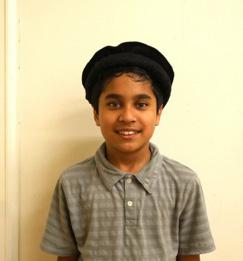
‘‘Verily, in the creation of the heavens and the earth and in the alternation of night and day, and in the ships which sail in the sea with that which profits men, and in the water which Allah sends down from the sky and quickens therewith the earth after its death and scatters therein all kinds of beasts, and in the change of the winds, and the clouds pressed into service between the heaven and the earth — are indeed Signs for the people who understand.’’ (The Holy Qur’an 2:165)
This verse reminds us that everything we see—like the sky, the rsain, the mountains, and even the animals—are signs that God created them. Think about the rain. When it falls from the sky, it helps plants grow, and we get food to eat. The cycle of rain, plants, and life is not something that happened by accident. It is perfectly balanced. This balance shows that there is a Creator who planned everything carefully.
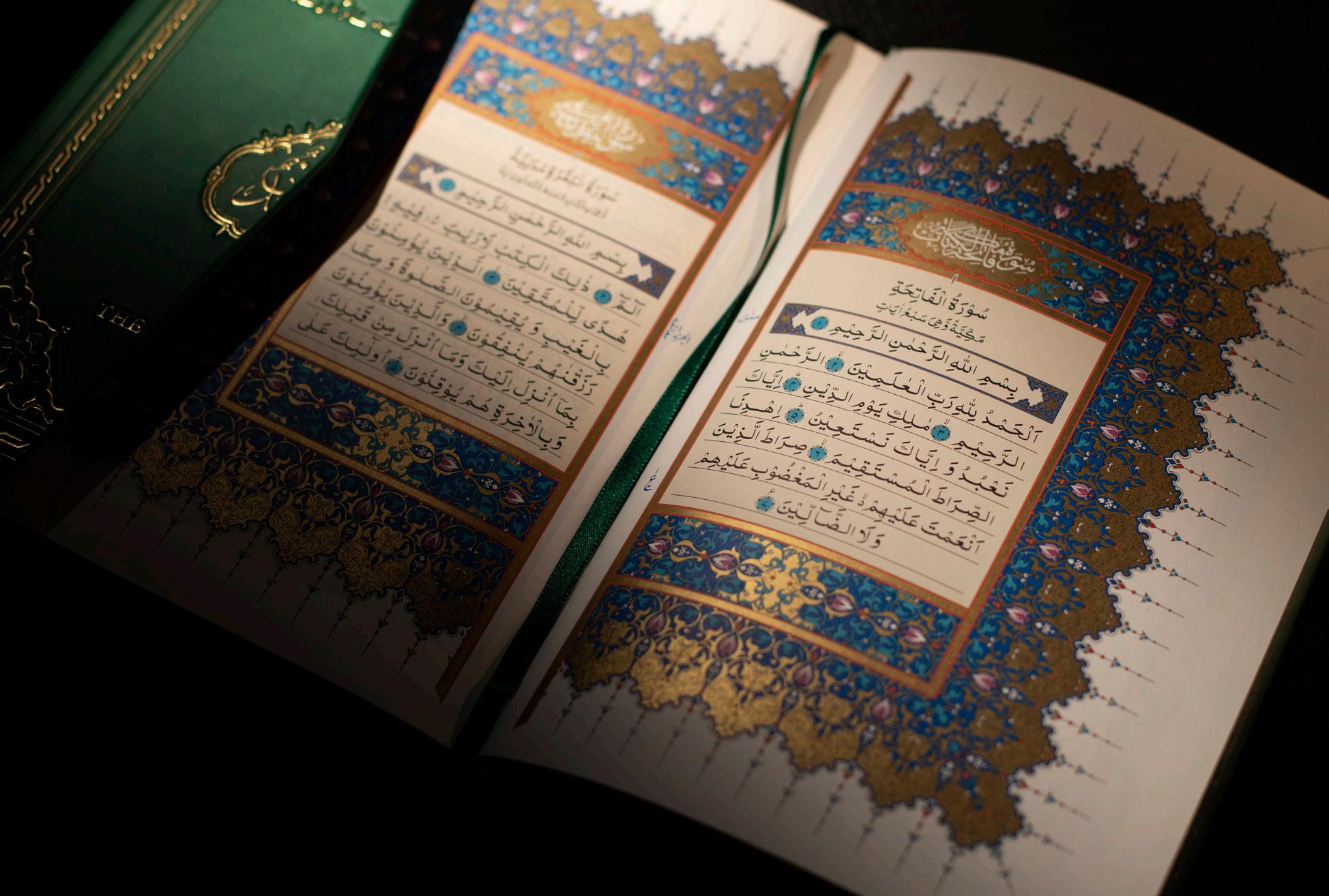
Have you ever looked closely at a flower? Or noticed how birds know exactly where to fly when they migrate? These are all examples of the amazing design in nature. The Qur’an tells us that everything in the world has been created with a purpose and plan. The Qur’an says:
not see any mistakes. Everything is placed in the right way. The stars, the moon, the sun, and the clouds all work perfectly together. If there were no sun, there would be no life. If the Earth were too close to the sun, it would be too hot for us to live. If it were too far away, it would be too cold. The way the Earth is placed at the perfect distance from the sun is a sign that God designed it.
Another strong sign of God’s existence is the human body. The Qur’an tells us in about how humans are created:
‘‘Who has created seven heavens in harmony. No incongruity canst thou see in the creation of the Gracious God. Then look again: Seest thou any flaw? Aye, look again, and yet again, thy sight will only return unto thee confused and fatigued.’’
(The Holy Qur’an 67:4-5)
This verse tells us to look at the world carefully. When we look at the sky, we do
‘‘Verily, We created man from an extract of clay; Then We placed him as a drop of 17
sperm in a safe depository; Then We fashioned the sperm into a clot; then We fashioned the clot into a shapeless lump; then We fashioned bones out of this shapeless lump; then We clothed the bones with flesh; then We developed it into another creation. So blessed be Allah, the Best of creators.’’ (The Holy Qur’an 23:13-15)
These verses describe how a baby grows in the mother’s womb. From a tiny drop, God creates a human being with a heart, brain, eyes, hands, and legs. Every part of the body has a job, and they all work together perfectly. For example, the heart pumps blood, and the brain tells the body what to do. This kind of design is too perfect to happen by itself. It shows that there is a Creator who made us.

edge in the Qur’an that proves it is from God. The Qur’an contains truths about the world that no one knew at the time it was revealed. This shows that it is not a book written by humans but is the word of God.
Did you know that scientists have discovered that the universe is growing larger every day? What’s amazing is that the Qur’an mentioned this more than 1,400 years ago, long before scientists knew about it. It says in the Qur’an:
The Qur’an also reminds us that God is in control of everything. He is the one who gives life and causes death, He sends the wind and the rain, and He knows everything that happens. The Qur’an says:
‘‘And We have built the heaven with Our own hands, and verily We have vast powers.’’ (The Holy Qur’an 51:48)
This verse tells us that God created the universe and that it is expanding. This is one of the many examples of scientific knowl-
‘‘Has not He Who created the heavens and the earth the power to create the like of them?’ Yea, and He is indeed the Supreme Creator, the All-Knowing. Verily His command, when He intends a thing, is only that He says to it, ‘Be!,’ and it is.’’ (The Holy Qur’an 36:82-83)
This verse shows us that God is so powerful that if He wants something to happen, all He has to do is say "Be," and it happens. This power belongs only to God, and it proves that He is the Creator of everything.
The Qur’an also tells us to look inside ourselves for signs of God’s existence. It says:
‘‘And in the earth are Signs for those who have certainty of faith, And also in your own selves. Will you not then see?’’ (The Holy Qur’an 51:21-22)
This means that we can find proof of God not only in the world around us but also inside our own bodies and minds. Our ability to think, feel, and make choices is a sign that God created us with great care and wisdom.
The Qur’an teaches that there is only one God, and He has no partners. He is the Creator of everything, and He alone should be worshiped. It says:

The Qur’an gives us many reasons to believe in the existence of God. From the beauty and design of the world around us to the way the universe works, everything points to the fact that there is a Creator. God is the one who made the stars, the trees, the animals, and even us. The Qur’an tells us that if we look closely at the world and think about it, we will see that God exists and that He is in control of everything.
‘‘Say, ‘He is Allah, the One; ‘Allah, the Independent and Besought of all. ‘He begets not, nor is He begotten; ‘And there is none like unto Him.” (The Holy Qur’an 112:2-5)
This chapter of the Qur’an is very short but very important. It tells us that God is One, and there is nothing like Him. He is the only one we should turn to in times of need because He created us and everything else in the world.
For Muslims, the Qur’an is the ultimate guide that shows us who God is and how He wants us to live. By reflecting on the signs of God in the Qur’an and in the world around us, we can strengthen our belief in Him and appreciate the wonders of His creation.
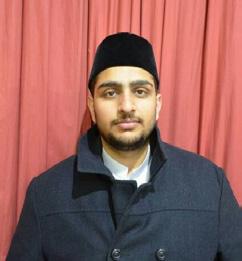

In a world filled with beauty, order, and mystery, the question of God’s existence has intrigued minds for centuries. As we gaze up at the stars or marvel at the complexity of a single cell, it’s hard not to wonder: Surely this cannot be an accident? Every sunrise and sunset, every breath we take, every moment of consciousness suggests that there must be something greater. Could this intricate design be the work of chance? Or does it point to an intelligent Creator who brought everything into existence with a purpose? Let’s dive into the clues hidden in the universe that point towards his manifestation.
The Quran mentions at one place:
“Who has created seven heavens in harmony. No incongruity canst thou see in the creation of the Gracious God. Then look again: Seest thou any flaw?” (The Holy Qur’an 67:4)
This verse reminds us that the universe is created so perfectly that it can’t be a mistake. It tells us that the heavens—everything from the skies to the entire universe—are created in perfect balance. When we look at the world around us, whether it’s the stars, planets, or even the smallest details like the way nature works, everything fits together without any mistakes.
The verse challenges us to take a closer look and see if we can find anything wrong or out of place. But when we observe the universe, we see that everything is finely tuned and works perfectly. This perfect design shows that it couldn’t have happened by accident.
This verse also encourages us to reflect on the universe and realize that its order and beauty point to a Creator. Everything is carefully made without flaws, showing the wisdom and mercy of God.
Look around at the world, the sky, and space. Have you noticed how everything seems to work perfectly? The Earth is at just the right distance from the Sun for life

to exist. If it was any closer, we would be burnt to a crisp. If we were a little farther, we would freeze. The amount of oxygen on Earth is just right for us to live—about 21% of the air we breathe. If there were much more oxygen, fires would break out easily and spread uncontrollably If there were less oxygen we would not even be able to light fires, impacting natural processes dependent on fire and significantly affecting plant and animal life.1 Gravity holds us perfectly in place and keeps the moon orbiting the Earth, allowing us to stay grounded. If gravity were any weaker, nothing would stay together—planets and stars wouldn’t form properly. If it were stronger, everything could collapse, making life impossible. Considering all of this, can it really be a coincidence and pure luck that we are at the exact perfect point for life to flourish? Everything is set perfectly for life to exist. This perfection suggests that the universe has been designed by a perfect being.
Life itself is an amazing mystery. Think about a tiny seed that grows into a huge tree, or how humans and animals are born and grow. Scientists understand parts of how life works, like cells, DNA, and repro-
duction. But there’s still something incredible about how life starts.
One of the most amazing things is DNA. It’s like a super-detailed instruction book inside every living thing. DNA tells your body how to grow, how tall you’ll be, the colour of your eyes—everything!2 Now, where did this super-complicated code come from? It’s too detailed to happen by accident. This suggests that life was designed carefully by a Creator.
The Quran mentions how God created life with purpose in Surah Al-Mu’minun (Chapter 23:13-15), where it describes the stages of a human being’s creation in the womb, long before scientists could explain it:

“Verily, We created man from an extract of clay; Then We placed him as a drop of sperm in a safe depository; Then We fashioned the sperm into a clot; then We fashioned the clot into a shapeless lump; then We fashioned bones out of this shapeless lump; then We clothed the bones with flesh; then We developed it into another creation. So blessed be Allah, the Best of creators." (The Holy Qur’an 23:13-15)
This shows how carefully and purposefully God created life. Such a complex and precise process couldn’t happen by itself or by chance. The development of a human being is so intricate that it points to the existence of a Creator who has the knowledge and power to design life in this way. It reminds us that God is behind this amazing process, guiding it every step of the way to bring us into existence.
What’s even more fascinating is that science has only recently uncovered the details of this developmental process. For centuries, people did not understand how life began and grew, yet this verse accurately describes it long before modern science revealed the same information.3

This verse was revealed a millennium and a half ago. It was written down and taught to Muslims all over the world long before we had the tools to study and comprehend it. The only possible explanation we have for this is that there is an all knowing Creator, who divinely reveals knowledge and truth to his chosen messengers, who in turn relay that knowledge to mankind. This reinforces the belief in God's existence and power.
References:
1. Belcher, C. M., Yearsley, J. M., Hadden, R. M., McElwain, J. C., and Rein, G. (2010b). Baseline intrinsic flammability of Earths’ ecosystems estimated from paleoatmospheric oxygen over the past 350 million years. Proc. Natl. Acad. Sci. U.S.A. 107, 22448–22453. doi: 10.1073/pnas.1011974107
2. Liu F, Wollstein A, Hysi PG, Ankra-Badu GA, Spector TD, Park D, et al. (2010) Digital Quantification of Human Eye Color Highlights Genetic Association of Three New Loci. PLoS Genet 6(5): e1000934. https:// doi.org/10.1371/journal.pgen.1000934
3. University of Innsbruck. “Tracing the origin of life.” ScienceDaily. ScienceDaily, 10 February 2023. <www.sciencedaily.com/ releases/2023/02/230210115508.htm>.
Majlis Atfal-ul-Ahmadiyya UK explorers club recently took over 38 Atfal, parents and Khuddam to visit Ghana.
Jalees Ahmad Ahsan shares his glimpses of Ghana



beloved Huzooraa has said on many occasions that Ghana holds a special place in his heart, and with the blessed opportunity to see why, I decided to go on a trip to Ghana in October this year
On day 1 (26th October), we arrived at the airport in Ghana at 8:40pm and, we were immediately welcomed with hugs and smiles by some Ghanaian Ahmadis. They welcomed us in a very loving manner just because we come from the same country as beloved Huzooraa. We arrived at the Accra mission house at 9:40pm and then we had a short sitting with Respected Sadr Sahib MKA Ghana where he gave us a warm welcome and introduced us to some national amila members and other Ghanaian Ah-
madis who would be assisting us over the course of the trip. After this we had dinner and ended the day.
On day 2, we offered Fajr at 5am. After that, we had a sitting with Respected Amir Sahib Ghana where he welcomed us very joyfully and met every single one of us as if we were friends reuniting after years of not seeing each other.
We then left for Kumasi at 11:40am and arrived at T.I Ahmadiyya Secondary school at Maghrib time where we were given a short introduction of the school. The headmaster over there told us it was one of the best schools in Ghana and was very popular. It was amazing to see how developed the Ghanaian jama’at was and how far they have gone.
After Maghrib and Ishaa in Asafo Mosque, Kumasi, we had dinner and, a short presentation of the mosque and on beloved Huzoor’saa visit to that mosque in 2004. I had the blessed opportunity to follow the footsteps of beloved Huzooraa and stand in the balcony where he stood to meet and say
Salaam to the Ghanaian Ahmadis in 2004. I never knew I would feel this much blessing to just walk into a balcony and look at the view, it was truly amazing. Finally, we made our way to our accommodation.
On day 3, we offered Fajr at 5am and then we left for Techiman at 7am to see a Jama’at hospital. After breakfast in Techiman, we went to the hospital over there which had many facilities to help anyone who needed it. Despite the hospital being relatively large, there were only 4 permanent doctors over there. It shocked me how 4 doctors could fulfil the needs of sometimes over 100 patients. The doctors put in a lot of effort and time to help these patients who needed treatment. The dedication of the Ahmadi doctors made me think about myself, how much time and effort am I putting in to help people? I believe that visiting this hospital has put a greater need in me to help others and to be compassionate towards them.
After visiting the hospital, we travelled to Tamale and reached there around 5pm. We visited beloved Huzoor’saa old residence. After seeing the humble and challenging conditions our beloved Huzooraa lived in, it made me self-reflect and think to myself that I live in the UK where I have access to many facilities, yet I am not being grateful enough for the little things I have that beloved Huzooraa and many other people didn’t have such as clean running water in my house and electricity.

After finishing the tour, we were given small Ghanaian flags and we all stood for a group photo. After the group photo, we all joyfully sang
in the famous Ghanaian style. During this, I became emotional just from a Ghanaian Ahmadi saying the words proudly and loudly. I can’t describe the feeling I felt but the words closest to it are that it touched my heart how faithful and connected to Allah and Khilafat the Ghanaians were.
Outside beloved Huzoor’saa residence in Tamale
My point is further supported by how we were greeted at Tamale Mosque. We were met with the same words,
The greeting we got made me realise how lucky I am to live near to the Khalifa of the time. Despite being ordinary Ahmadis, we were only greeted this way because of where we come from. We were told that the Lajna had stopped what they were doing just to greet us. This made me very emotional and made me ask myself, who am I? who am I, that people stop their work just to say Sa-

laam to me? This shows how spiritually advanced the Ghanaian community is. Finally, after dinner, we prayed Maghrib and Ishaa and went to our accommodation around 7:50pm
We made our way to Salaga T.I. Ahmadiyya senior high school and on the way, I saw the roads were very dusty and had many potholes and was sometimes very rocky. Despite being in a comfortable coach, the journey was sometimes a little rough. However, I can’t imagine how difficult the journey would’ve been for beloved Huzooraa. I couldn’t imagine what the situation of the road was back then and travelling by bicycle or tractor would have made the journey from Tamale to Salaga much worse than sitting in a coach. This just shows how many sacrifices our beloved Huzooraa had to make to bring water and other essentials for his family and the needy.
When we arrived at the school, of which beloved Huzooraa was the headmaster of from 1977-1979. It was a large school and again it showed that not only is the Ghanaian Jama’at developed spiritually but is also well developed in terms of services to humanity
such as schools.
After visiting the school, we made our way to the place where beloved Huzooraa resided in Salaga, and we saw the well from where he got water from. We saw the modest conditions beloved Huzooraa lived, and it showed me that even before Khilafat, beloved Huzooraa was a humble man due to the conditions he lived in. After this, we travelled back to Kumasi and reached our accommodation around 10:30pm where we stayed for the night.
On day 5, after fajr at 5am, we left our accommodation at 7:05am and we travelled to back to Asafo Mosque, Kumasi and reached there at 8am. After breakfast, we visited children at T.I Ahmadiyya basic school. All the children over there were very excited and enthusiastic to see us. Some of us had chocolates and biscuits to give to the children and it was a very good atmosphere, and everyone was smiling while meeting the students.
After this, we left Kumasi at 9:15am to go to Mankessim where we were going to visit Jamia Ahmadiyya International Ghana. During the journey, some of the national amila members of Ghana and a murrabi sang songs of praise, such as
The atmosphere of the coach was very lively and everyone forgot how long we had been travelling.
On arrival to Jamia Ahmadiyya Interna-
tional Ghana at 1:28pm, we were greeted the same as when we arrived at the airport on the first day, with smiles and hugs. As soon as we entered Jamia, I was amazed at how much effort and time the students and the teachers put into organising tables for us to eat lunch. They had 2 large tables setup with bottles of cold water and cold drinks. After lunch, we were given a tour of Jamia, and we met the Vice Principal and the Principal who we had a small Q&A with. After visiting Jamia, we visited Saltpond beach which was the former location of Jalsa Gah. We also visited where the first Jama’at mission started and the port where Hazrat Maulana Abdul Raheem Nayyar Sahibra arrived. After this we visited one of Ghana’s first mosques built in 1949, the first mission house established, and school established in 1923. Finally, we arrived at Jamiatul Mubashireen at 6pm for dinner and to stay overnight.
On day 6, we had fajr at 5am, and breakfast at 8am. We then attended an assembly in Jamiatul Mubashireen. We then went to the Madrasatul Hifz where Atfal were trying to memorise the Holy Quran. After that, we went to T.I Ahmadiyya Primary school in
Ekrawfo. After that, we went to a graveyard where we prayed at the grave of the first Ghanaian Ahmadi. Near to the graveyard, we visited the mosque nearby and then we went to T.I Ahmadiyya Secondary school Essakyir where beloved Huzooraa was headmaster from 1979-1983. We also visited the place beloved Huzooraa stayed in Essakyir during his time over there. After that we went to the river where beloved Huzooraa would get water from. Around 1pm we went to Winneba beach and strengthened our brotherhood by playing football and playing in the water. After that, we made our way back to Accra and on the way, we saw Bagh-e-Ahmad which is a plot of land owned by the Jama’at where farming occurs and where National Ijtema used to occur. We reached Accra at 6pm and after dinner and Maghrib and Ishaa namaz we went to bed.
On day 7, after Fajr at 5am, we had breakfast at 8am and at 12:30, we had a small Jummah and prayed before beloved Huzoor’saa khutba. After the khutba ended, lunch was hosted by Majlis Atfal-ul-Ahmadiyya UK and it was very delicious. We invited Respected Sadr Sahib, former Sadr Sahib and everyone who was involved in planning this trip. After lunch, we visited Bustan e Ahmad and after that, we made our way to MTA Ghana, Wahab Adam studios. We

saw where translations are made of the Friday sermon, where different programs are filmed and many other places. We had dinner over there and made our way back to Accra central mosque for Maghrib and Ishaa and after dinner, we went to bed.
As we offered our Asr prayer in the bus whilst travelling to Bustan e Ahmad, the bus driver was very impressed and said that he had never seen anyone praying like this. He enquired about the Jama’at and was very impressed about Ahmadiyyat. He was given an introduction about the Promised Messiahas, his advent and the Jama’at. And we gave him some Jama’ati literature. He offered Maghrib & Ishaa prayers with us. Upon us saying that one day all these Masajid will belong to Jama’at Ahmadiyya, he very strongly said Insha’Allah. This shows that the Ghanaian Ahmadi Jama’at is held in high regard by non-Muslims and non-Ahmadis.
On day 8, we started our day with Fajr at 5am and then breakfast was served at 8am. At 11am, we made our way to Oxford Street for shopping and retuned at 1pm to Accra Central Mosque for Zuhr. At 2pm, we had a session with Respected Naib Ameer Sahib and Respected Sadr Sahib.
The sessions started with Tilawat, a few words from Respected Naib Ameer Sahib, Respected Sadr Sahib and our Ameer e Qafla Respected Musharraf Ahmed Sahib. After that, some Atfal shared their experiences. After that, every single member of the trip from the UK received a scarf from Naib Ameer Sahib. After that, we gave gifts to the people who assisted us on the trip such as the 2 police officers, national amila members etc. After that, we had a special lunch in which we were given a range of options.
Session with Naib Ameer Sahib and Sadr Sahib
After lunch, we had a group photo then Asr
namaz. Then, everyone went to their rooms and started to pack in preparation for departure. We had Maghrib and Ishaa around 6pm and after that, some of us got interviewed by MTA on our experience on the trip. We were also given free shirts which had Ghanaian colours and the flag of both Ghana and the UK, and on the back, it said, “following the footsteps of a holy man.” Then, around 7pm we left for the airport and our flight was at 11:30pm. Alhamdullilah, we arrived at Heathrow around 6:15am on Sunday 3rd November.
I learnt many things on this trip. For example, I learnt that you should never take things for granted. I never knew I would be in a position where I would be praying for warm water and soap. I have also had a strong reminder on this trip of how lucky I am to live in the UK. Every Ahmadi should take advantage of the fact that we live in the UK, we should try and pray behind beloved Huzooraa when we can. This trip has made me go from writing to beloved Huzooraa a few times a month to few times a week. I have also learnt the spiritual state of Ahmadis around the world. Despite having a large physical distance from beloved Huzooraa, Ahmadis across the world are spiritual neighbours to beloved Huzooraa. The Ghanaian Ahmadis were very committed and sincere to the Jama’at and Khilafat. They showed the impressive spirit of brotherhood. This trip has brought many changes in how much time and effort I give to gaining more religious knowledge, the Jama’at and my loved ones. I believe that trips like these are very helpful and beneficial in bringing people close to Allah.
Experiences like these are hard to describe in words since you can’t describe someone’s love for Allah in words, you must be there to experience it. The hospitality shown by the Ghanaian Ahmadis towards us, despite us meeting them for the first time, shows the unmatched bond of brotherhood created by the blessings of Khilafat-e-Ahmadiyya.
Iftekhar Ahmed Sahib
•Where are you posted and what is your daily routine?
My duty is primarily at the Ahmadiyya Archive & Research Centre, where I spend most of my time. The Ahmadiyya Archive & Research Centre (ARC) was founded in October 2014 by Hazrat Mirza Masroor Ahmad, Khalifatul Masih Vaa, to preserve the history of the Ahmadiyya Muslim Jama’at. Its primary goal is to save fragile historical documents, especially autograph documents from the Promised Messiahas and the Khulafa.
A portion of my work also involves supporting MTA International’s Online and Social Media Department. I arrive at the office in the afternoon and focus intensely on the tasks at hand. Every day brings unique opportunities – whether uncovering historical insights or creating new content to inspire and guide the Jama’at’s global audience. This daily work, though routine on the surface, feels like a sacred mission to help preserve and promote the message of Islam Ahmadiyyat.
•Was there anyone who inspired you to become a Murabbi?

My inspiration came from my mother, who embodied a profound love for Allah and a dedication to His cause that I witnessed growing up. Even before the Waqf-e-Nau scheme was announced, my mother, in her gratitude to Allah, for blessing her with a son, vowed to devote me to His service from the moment I existed in her womb. Her life was a model of piety and deep spiritual awareness, and she seemed to have an innate connection with Allah, marked by experiences of true dreams and deep insight. Watching her live with such devotion ignited in me the desire to dedicate my life to the service of Allah, and I strive each day to live up to the example she set.
• Could you tell us about any recent research you’ve conducted that holds personal significance?
In my current research, I delved into what is known as the “argument from commitment,” or ilzam in Arabic, and izami jawab in Urdu. This fascinating concept has a rich history, from Greek philosophy to its application in Islamic scholarship, particularly within Christian-Muslim polemics. This research is significant to me because the Promised Messiahas also employed ilzam to highlight inconsistencies in opposing views and to bring people closer to the

truth. Through tracing the historical evolution of this concept, I aim to deepen our understanding of how logic and reason are harnessed in the service of faith and to offer insights for those who engage in defending Islam with intellectual and spiritual rigour.
•Describe some of the challenges you face in the field and how have you tackled them?
Researching Islamic history and doctrine often involves painstaking efforts to locate and authenticate original sources. Another challenge is interpreting these sources in a way that places them accurately within the broader historical and theological framework. Over time, I’ve developed methods for overcoming these obstacles: drawing on experience, building an extensive network of contacts, and, above all, embracing meticulous reading and in-depth study. Each source I uncover feels like uncovering a
precious gem, adding clarity and depth to our understanding of our faith’s history and teachings. This meticulous work is challenging but ultimately rewarding, as it strengthens our collective understanding and supports the mission of spreading the message of Islam.
• Can you share your journey and experiences in this field, including any moments that strengthened your faith?
My initial posting in this department had actually been in December 2021. At the time, I was also studying at university, following Huzoor’saa guidance. There were some discussions about whether I should continue my studies or pause them due to my posting. However, Huzooraa instructed me to complete my studies, which I did in mid-2023, before arriving here in early 2024. I came alone, leaving my family be-
hind in Germany.
Upon arrival, I joined a team that was already well into research for an exhibition project. I began my own research work as well, as research has always been my passion, dating back to my time in Jamia. My passion for research has a story, I initially applied for Jamia UK in 2005 with the first batch, but I wasn’t accepted. At the time, I was in 11th grade, so I decided to complete my A-Levels (Abitur in Germany) by 2007. I intended to reapply for Jamia UK, but officials in Germany suggested I wait a year and apply for Jamia Germany, which was set to open in 2008 with Huzoor’saa permission. During that year, I enrolled in Business Informatics, a crossover of IT and economics, as a backup in case I wasn’t accepted. After completing two semesters, I reapplied to Jamia and was accepted in 2008. Alhumdolilah
I was a keen internet user, diving into discussions about the Jama’at, particularly addressing allegations against it. Websites and social media, especially ‘X’ formally known as Twitter (which had just started), became platforms where I encountered various criticisms. Seeing a lack of readily available answers, I began researching these issues myself, looking into original sources, context, and background, and then responding to these allegations on my blog and Twitter. This self-directed research honed my skills, and eventually, people began seeking my help with finding sources, even teachers at Jamia.
After graduating in 2015, I joined various online groups where my research skills continued to be useful. My research, particularly finding answers to difficult ques-
tions, often on topics that had not been previously addressed, didn’t go un noticed.
Shortly after my arrival in the UK, I came across a magazine from 1924 with previously unseen photos of Hazrat Khalifatul Masih II’sra journey from Bombay to the Arab world. The magazine featured images of Huzoorra praying, with members of his entourage behind him. It was incredible seeing it for the first time, I then also located and ordered an original copy of the magazine.
Finding these images was like searching for gold and actually striking it. It was a remarkable and faith-inspiring experience…
•What is the most rewarding aspect whilst serving in this field?
To be given the opportunity to serve in a field that is also my passion feels like a blessing beyond words. Researching, studying, and sharing the insights and teachings of Islam Ahmadiyyat feels more like a calling than a job. To work each day in service of this noble mission is, to me, a response to my prayers, and I am profoundly grateful to Allah for this role.
•Can you please share with us any special memorable moment with Khalifatul-Masihaa which stuck with you?
One particular moment that profoundly impacted me was Huzoor’saa interview for the launch of the Existence Project, which he gave to the Review of Religions. In his interview for the Existence Project, Hazrat Mirza Masroor Ahmad, Khalifatul Masih Vaa, discussed the spiritual insights that
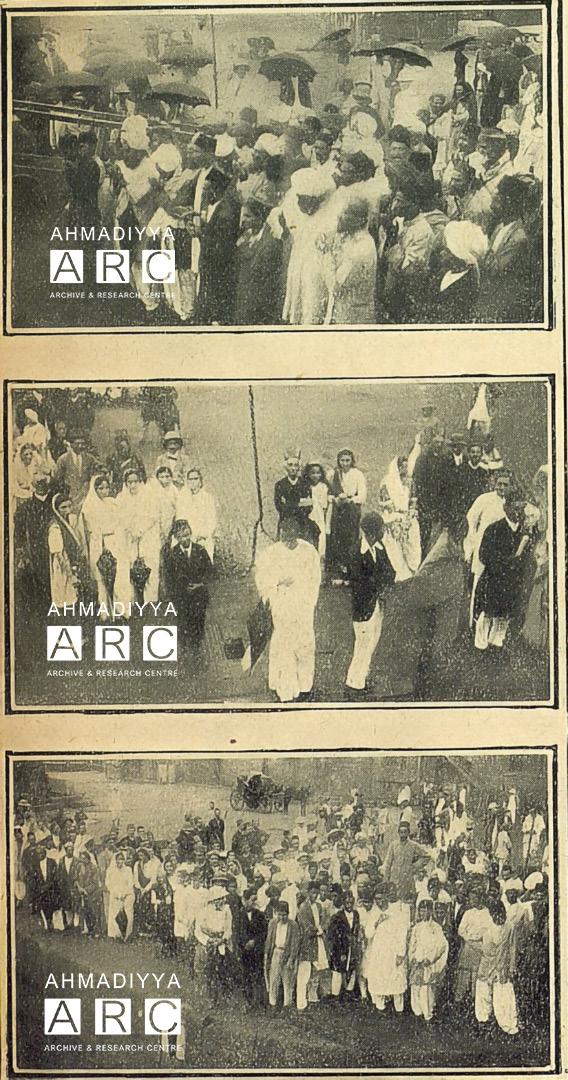

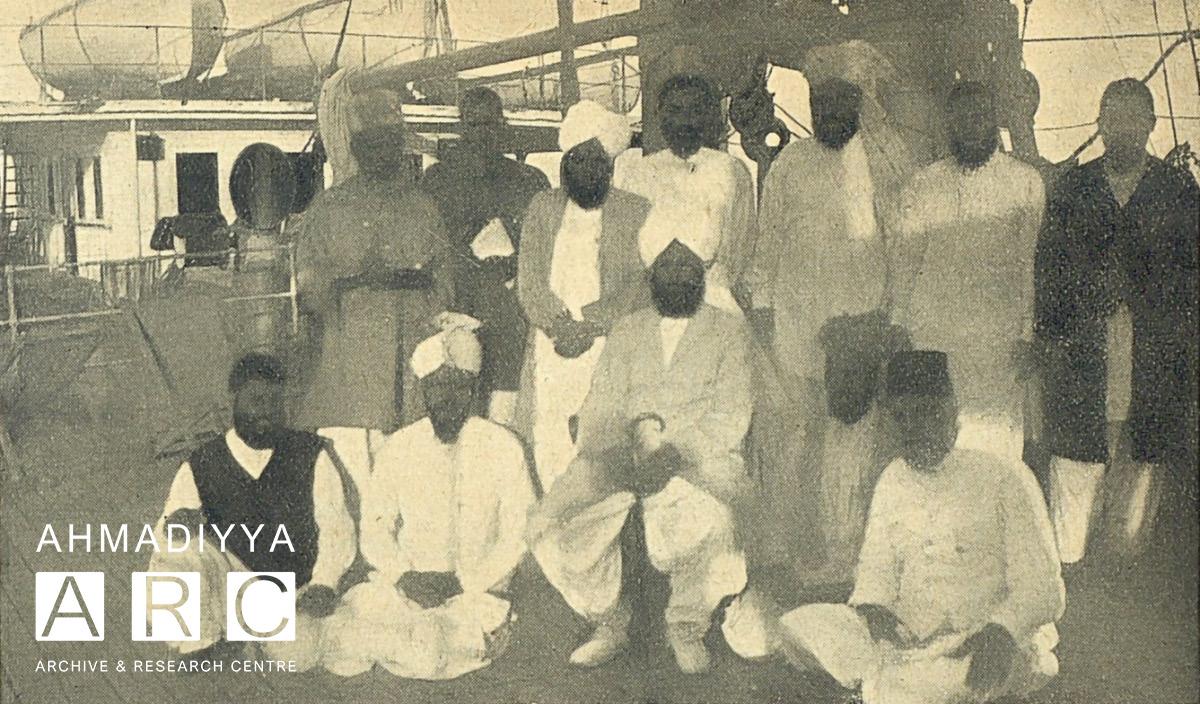
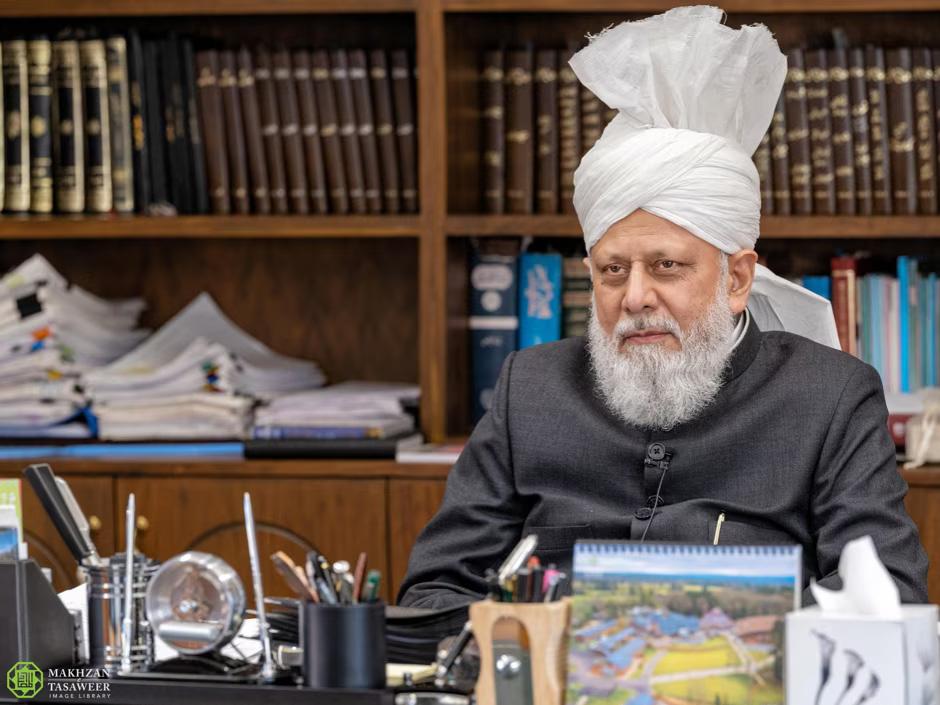
Allah sometimes grants him about individuals. He explained that while he may occasionally be divinely inspired regarding someone’s state, he can often read a person’s character through their demeanor and body language. His Holiness also addressed the experiences of answered prayers among Ahmadi Muslims, emphasizing that these personal accounts should be shared, regardless of similar claims by others. He noted that while people of other faiths, including non-Ahmadi Muslims, may claim miraculous effects from prayers, it is not for us to verify or refute such claims. Instead, the focus should be on presenting one’s own experiences and leaving the matter of belief and conversion to Allah. His Holiness emphasized that true faith brings inner peace and satisfaction, a condition that cannot be artificially induced or maintained through
psychological or superficial experiences.
•How important is it for a Murrabi to keep in constant contact with Khalifatul-Masihaa?
For a Murabbi, the most essential duty is to remain loyal to the service of the Khalifa of the time. Our bond with him is in our obedience, fulfilling his instructions and upholding the standards he sets for us. This is the true connection with the Khalifa, as it deepens our sense of purpose and keeps our intentions aligned with his vision. To remain in constant spiritual contact with the Khalifa is to be fully committed to serving the Jama’at in the way he has guided us to.
•What advice would you give to an-
yone who wants to join Jamia to become a murrabi but is unsure about this life changing decision?
I would say, reflect deeply on whether you are ready to dedicate your life to Allah’s cause. Becoming a Murabbi is not merely a career – it is a covenant with Allah. It involves prioritising faith over worldly desires, placing the needs of the Jama’at above personal relationships, and accepting a path that demands humility, sacrifice, and unwavering dedication. If you feel prepared to leave behind worldly attachments and live solely for Allah, then the Jamia Ahmadiyya is the place for you. But if this feels uncertain, take time to build this inner readiness. Entering this life path without clarity would not only be a disservice to yourself but could also strain the precious resources of the Jama’at.
•Not every Murrabi/Waqif-e-Zindagi will be posted near Huzooraa. What advice would you give for those Waqifeen-e-Zindagi that are posted far away from Markaz
The advice I will give to anyone that is posted far away from Markaz is that the measure of one’s proximity to Huzooraa is not in physical distance but in one’s closeness to Allah. No matter where we are stationed, we serve under the shadow of Allah’s guidance, and He is always near to us.









Assalam O Alaikum, I am Schehar Yar Khan, I’m 24 years old. I have a bachelor’s degree in International Business. I have had the blessed opportunity of serving in various departments within the Jama'at, under Atfal-Ul-Ahmadiyya UK, Muslim Television Ahmadiyya and Voice of Islam UK where I have had the opportunity to contribute to spreading the message of True Islam.
Can you please tell us a bit about what you have studied and how you have been serving within the Jama’at in various capacities?
Assalam O Alaikum, I am Schehar Yar Khan, I’m 24 years old. I have a bachelor’s degree in International Business. I have had the blessed opportunity of serving in various departments within the Jama'at, under Atfal-Ul-Ahmadiyya UK, Muslim Television Ahmadiyya and Voice of Islam UK where I have had the opportunity to contribute to spreading the message of True Islam.
You have mentioned some of your work with Voice of Islam Radio Station. What are some of your day-to-day tasks?
At Voice of Islam, I serve under the Studio Engineering department, where I manage a wide range of technical and operational tasks essential for the smooth functioning of our 24-hour radio broadcasts. My dayto-day responsibilities include:
• Sound Engineering & Audio Control: Managing and controlling audio levels to ensure clear, high-quality sound output during live broadcasts and recorded segments. This includes fine-tuning audio mixes and balancing various audio inputs to maintain an optimal sound experience for listeners.
• System Maintenance & Testing: Performing routine testing and maintenance of studio equipment and servers to prevent technical issues and ensure reliability.
• Broadcast Oversight: Overseeing the live broadcast process, monitoring for quality and consistency, and responding to any issues that arise in real-time.
• Editing & Quality Assurance: Editing pre-recorded content and performing
quality checks to maintain our standards, ensuring content is broadcast-ready. This includes audio editing and fine-tuning to enhance listener experience.
• Equipment Installation & Integration: Installing new studio equipment and coordinating the integration of these systems with existing setups. Ensuring all equipment meets our technical requirements and is functioning as expected.
• Studio Bookings & Scheduling: Managing studio bookings, coordinating with various departments to arrange schedules for recordings, live sessions, and other uses of the studio space.
Is there anyone who has specifically inspired you?
Yes, I am deeply inspired by Khalifatul-Masih Vaa. Huzoor’s consistent blessed guidance and vision for the Jama’at motivates me every day. His dedication to peace and service is truly inspiring. Additionally, my parent’s commitment to serving the Jama’at has been a constant example for me throughout my life. Their support has encouraged me to keep going, even when the tasks are challenging. Together, these influences shape my values and aspirations, driving me to make a positive impact wherever I can.
What creates passion and motivation when you are carrying out your duties within the Jama’at?
My motivation comes from knowing that every effort, big or small, serves a greater purpose in the sight of Allah. The Jama’at’s mission of bringing people closer to God and promoting peace resonates deeply with me, which keeps me dedicated. Also, being part of a community of like-minded people striving for the same goals helps me stay focused and passionate.

How can we attain the pleasure of Allah Ta’ala when we serve within the Jama’at?
I believe that we can attain Allah’s pleasure by serving with sincerity, humility, and gratitude. Our intentions matter greatly, so I strive to remind myself that each task is an opportunity to serve Allah. Keeping regular in prayer and staying mindful of our purpose allows us to seek and attain Allah’s pleasure. Additionally, following the consistent guidance of Khalifatul-Masihaa reminds me to strengthen my connection, draw closer and build that relationship with Allah Ta’ala through 5 daily prayers.
For a Waqif-e-Nau who is interested in pursuing studio engineering or a similar field, what guidance would you give them? How can one pursue this field?
If you’re a Waqif-e-Nau interested in volunteering as a studio engineer, I encourage you to reach out to VOI (Voice of Islam), which offers comprehensive training programs to equip you with all the essential skills that you need. Gaining hands-on experience is key. At VOI, we are always looking for passionate individuals to join our team!
How are you still keeping in touch with Khalifatul-Masih Vaa, and why is it important to have that bond with him?
I keep in touch with Huzooraa through regular letters, where I seek guidance and share updates with Khalifatul-Masih Vaa. Attending Jama’at events and listening to Huzoor’s Friday sermons regularly helps me stay connected to my faith and get closer to Allah. This bond is so important, Huzoor’s direct guidance and prayers help me stay firm with my faith and helps me get through all challenges that life throws at me whether small or big as it strengthens my faith and reminds me of our mission
How do you see yourself serving the Jama’at in the future?
In the future, I hope to continue to be able to serve the Jama’at in various capacities. I also aim to inspire others who are interested in similar fields, sharing the skills and experiences I have gained. My goal is to continue working closely with the Jama’at to help spread the true message of Islam and be of service in any way I am needed.
We are seeking passionate and dedicated Waqifeen-e-Nau as well as Waaqifaat-e-Nau volunteers to join the Voice of Islam team in a variety of impactful roles, including:
• Producers
• Researchers
• Social Media Coordinators
• Administrative Support
• Blog Writers
• Technical Staff
• Web Developers
To Volunteer, please scan the QR code to complete a brief questionnaire and apply. We look forward to welcoming you to our team!


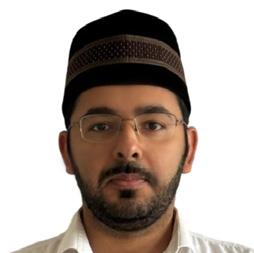
One of the deepest and most timeless inquiries of the human soul is the existence of God. The thought transcends the boundaries of culture and creed. Islam, in its essence, affirms the oneness of God, Tawhid, as the very foundation of existence and purpose. Through the evidence of divine order in nature, the lives of prophets, and the miracle of the Qur'an, both heart and mind are invited to recognize the existence of God whose presence echoes through every layer of existence.
Prophets serve as a living proof of God’s existence, reflecting His attributes of mercy, wisdom, and justice through their lives. Through their divinely inspired teachings and lives, prophets reveal that God is neither distant nor silent but actively involved with His creation with miracles and other forms of extraordinary signs. As the Promised Messiahas explained:
“Miracles are not mere spectacles; they are essential for manifesting divine majesty, guidance, and power. God shows His
signs to bring seekers closer to Him, to help people recognize that He exists, and to strengthen the conviction of the righteous” (Izala-e-Auham, Vol. 2, p. 235).
Promised Messiahas notes that when a person sincerely follows the way and life of a prophet, it results in deep moral and spiritual transformations, affirming that only a divine source could bring about such far-reaching change:
“Your only real effective remedy is that the Holy Spirit, which specially descends from the hand of God, should turn your face towards virtue and righteousness. Become the children of heaven, not the children of earth.” (Kashti Nuh, page 73).
The Argument of Fitrah (Human Nature) suggests that every human being is born with an inherent recognition of God and a moral compass distinguishing right from wrong. This innate disposition, known as "fitrah," is understood in Islamic teachings as a natural inclination toward God.
When person uses the moral compass and starts choosing right from wrong, he would end up following guidance of God. Hazrat Mirza Bashiruddin Mahmud Ahmadra explained this concept in his Tafsir of Surah Al-Anbiya that the Quran views belief in God as harmonious with human nature, as shown in the verse from Surah Ar-Rum: "So set thy face to the service of religion as one devoted to God. And follow the nature made by Allah — the nature in which He has created mankind. " (30:31). This verse indicates that Islam aligns with the human essence, embedding belief in God and moral principles within each person.
Prophets play a crucial role by reawakening this dormant knowledge of God within people. Their teachings resonate with human fitrah, reminding individuals of their inherent connection to God. Even though external factors like upbringing and societal norms can obscure this innate nature, prophets, scholars, and religious leaders guide people back to their original state, free from societal misguidance.
A hadith from Prophet Muhammadsa illustrates that while every child is born on right fitrah, external influences shape their beliefs and behaviors (Sahih al-Bukhari 1385; Sahih Muslim 2658). This fitrah also interacts with human free will, allowing individuals the choice to accept or reject this natural inclination. This balance between fitrah and free will gives depth to the human experience, as choosing to align with one's fitrah brings spiritual fulfilment and closeness to God. This idea connects to the Quranic verse in Surah Al-A'raf (7:172), where God affirms humanity’s inherent knowledge of His existence, highlighting the pre-worldly covenant that all humans bear witness to God's lordship.
The concept of "Order and Design in Nature" suggests that the universe's complexity and precision indicate a purposeful creation. This intricate design implies a guiding hand for all things toward balance and intention. Natural patterns—like the cyclical seasons, water cycle, and the balanced positioning of the Earth have signs for the people who think. Quranic verses illustrate this, stating that all creation is measured and intended for balance. Just as natural laws (like gravity) maintain physical harmony, spiritual laws (such as charity and justice) uphold moral order.
Both natural and spiritual laws serve meaningful roles, guiding physical existence and ethical behaviour. Breaking natural laws leads to environmental or health consequences, just as ignoring spiritual laws causes moral decline and unrest. This balance is reinforced by interdependence: human actions toward nature impact societal and spiritual health, and vice versa.
Just as the Quranic principle of amr bil ma’ruf wa nahi anil munkar (enjoining good and forbidding evil) underscores the importance of moral conduct, the Quran further emphasizes that everything in creation is designed with balance and proportion: "He has created everything and has ordained for it its proper measure" (Surah Al-Furqan, 25:2).
The peace that Ahmadis experience through prayer serves as profound evidence of God’s existence, offering comfort that transcends worldly concerns. For Muslims, Salah is far more than a ritual; it is a means of deep communion with God, fostering inner

calm, resilience, and transformative emotional strength. Hazrat Mirza Bashiruddin Mahmud Ahmadra emphasized that this is a unique gift from God. Prayer shapes the believer's character, reduces stress, and reinforces faith, granting lasting peace unmatched by any material comfort.
As Hazrat Mirza Bashiruddin Mahmud Ahmadra described, "Hearts find comfort in dhikr. Why? This is so because anxiety develops when man thinks that he is about to be destroyed by some calamity and if he believes with certainty that there is a remedy for every calamity and ailment, then he will not become anxious. Thus, when someone remembers Allah and understands that Allah possesses unlimited powers and can remove all types of ailments, his heart tells him that when he has such a God, then what is the need for him to become anxious about any difficulty? He will Himself remove it. In this way, he finds comfort." (Remembrance of Allah page 109)
Also in Quran:
“.. it is in the remembrance of Allah that hearts can find comfort;” (Surah Ar-Ra’d, 13:29)
The historical continuity of religion suggests that a consistent divine message has been delivered to humanity across different eras, cultures, and regions, pointing to a single, guiding divine source. This continuity, especially the recurring theme of monotheism—from early prophets like Hazrat Adamas and Hazrat Nuhas to later ones such as Hazrat Musaas, Hazrat Isaas, and Nabi Kareem (SAW)—indicates that these prophets were not independent thinkers but were divinely appointed messengers within a unified divine mission. The Quran supports this by stating that no nation has been left without guidance: “And We did raise among every people a Messenger, preaching: ‘Worship Allah and shun the Evil One.’” (Surah
An-Nahl, 16:37). This message’s presence in cultures with no direct contact further suggests a divine, rather than human, origin. Although adapted to specific cultures, the core teachings—submission to God, moral conduct, and belief in the afterlife—have remained constant, as seen in the ethical teachings of Judaism, Christianity, and Islam. This shared framework reinforces that the prophets’ message transcends history and culture and is part of spiritual guidance.
The Quran is viewed as a "living miracle" due to its timeless guidance, unique linguistic beauty, and profound impact on readers. Its divine origin is evident in several ways: Inimitability (I'jaz al-Quran): The Quran’s linguistic and spiritual depth is unparalleled, and despite challenges, no one has been able to replicate its style and eloquence. This unmatched quality serves as a testament to its divine origin. (Surah Al-Baqarah, 2:24)
Preservation: Unlike other scriptures, the Quran has remained unchanged for over 1,400 years, as promised in (Surah Al-Hijr, 15:9). Its preservation, both written and through memorization (Hifz), is considered miraculous.
Scientific Insights: The Quran contains descriptions of natural phenomena and human development that align with modern scientific discoveries, like embryonic stages. (Surah Al-Mu’minun, 23:12-14)
Guidance for All Times: The Quran addresses universal issues—justice, morality, and social welfare—making its teachings relevant across eras and cultures. Its principles continue to guide and resolve contemporary challenges. "This is a perfect Book;
there is no doubt in it; it is a guidance for the righteous." (Surah Al-Baqarah, 2:2)
Spiritual and Moral Transformation: The Quran has the power to transform individuals and societies from pagan Arabs to Mongols, promoting justice, compassion, and personal growth, which has inspired revolutions throughout history. (Surah Bani Israil, 17:9)
Prophecies: The Quran contains fulfilled prophecies, such as the defeat of the Romans. (Surah Ar-Rum, 30:2-4)
Impact on Language and Culture: The Quran elevated Arabic literature and philosophy, establishing it as the pinnacle of linguistic excellence, with a lasting cultural impact across the Islamic world.
In conclusion, the existence of God is interwoven throughout the fabric of human experience, manifested through natural order, the lives and guidance of prophets, and the transformative power of the Quran. Through the teachings of prophets, individuals are reminded of their inherent connection to the God, an awareness rooted in human nature, or fitrah. This intrinsic knowledge, aligned with the signs in nature and the inner peace of prayer, becomes a pathway to God for those who seek Him sincerely. The historical continuity of revelation and the Quran as a living miracle further underscore that Islam’s message is universal, guiding humanity to a life of spiritual fulfillment, moral clarity, and peace. This holistic vision invites each person to recognize and experience God’s presence in every aspect of existence, bringing purpose and meaning to the journey of life.
In order to safeguard ourselves from the onslaughts of Satan and to attain refuge in an invincible and tall citadel of Allah’s protection, Hazrat Khalifatul Masih Vaa encouraged us all to pray these particular prayers

“‘Holy is Allah and worthy of all praise, Holy is Allah, the Great. O Allah, send down Your blessings upon Muhammad and upon the progeny of Muhammad.’
I seek forgiveness from Allah, my Lord, for all my sins and turn to Him
“‘O my Lord everything serves You. So O my Lord, protect me and help me and have mercy on me.’
“Those of middle age, from 15 to 25 years old, should recite it at least 100 times. Children should recite it at least 33 times. Little kids should be helped by their parents to recite it three or four times. Additionally, everyone should seek forgiveness (Istighfar) 100 times.